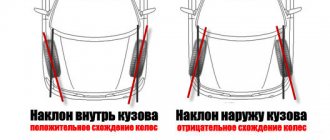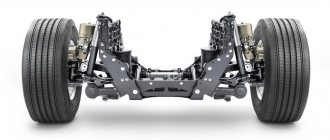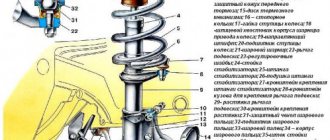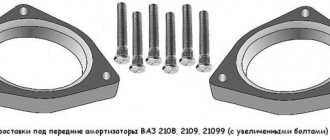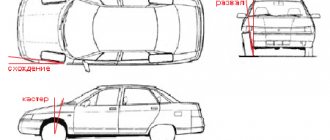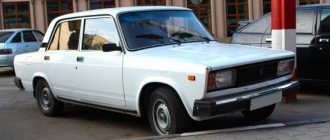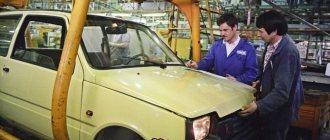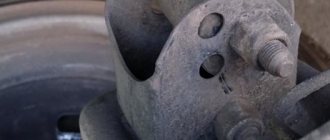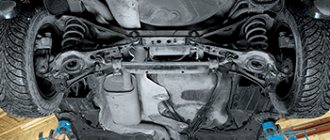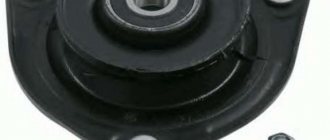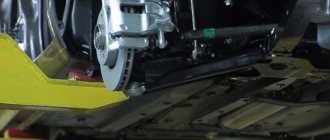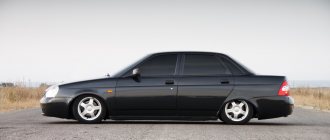The double-wishbone suspension with short upper and long lower arms ensures minimal lateral movement of the wheel (harmful to the lateral stability of the car and causing rapid tire wear), as well as minor angular movements during up and down travel. The wishbone configuration allows each wheel to independently absorb bumps and remain more upright on the road surface. And this means better grip.
MacPherson suspension, named after the engineer Earl MacPherson who developed it in 1960, is a wheel suspension consisting of a single link, an anti-roll bar and a unit of spring element and telescopic shock absorber, called a swaying plug, due to the fact that it It is fixed in the upper part to the body using an elastic hinge and can swing when the wheel moves up and down.
Kinematically, the scheme is less perfect than a suspension on two transverse or longitudinal arms: that with a large suspension stroke, the camber (the angle of inclination of the wheel to the vertical plane) will change, and the more, the greater the suspension stroke. But due to its manufacturability and low cost, this type of suspension has become very widespread in the modern automotive industry.
Multi-link suspension is somewhat reminiscent of double-wishbone suspension and has all its positive qualities.
These suspensions are more complex and more expensive, but provide a smoother ride and better vehicle handling. A large number of elements - silent blocks and ball joints - absorb shocks well when hitting obstacles sharply. All elements are mounted on the subframe through powerful silent blocks, which increases the noise insulation of the car from the wheels.
The use of multi-link independent suspension, which is mainly used on luxury cars, gives the suspension stable contact of the wheels with any surface on the road and precise control of the vehicle when changing direction.
The main advantages of a multi-link suspension:
-Independence of the wheels from each other, -Low unsprung weight, -Independent longitudinal and lateral adjustment, -Good understeer, -Good option for use in a 4x4 configuration. The main disadvantage of the modern scheme is complexity and, accordingly, price. Until recently, it was used only on expensive cars. Now it “holds” the rear wheels of even some golf cars.
Installation of pneumatic elements On all suspensions described above, the pneumatic element is installed according to a similar scheme. It fits onto the shock absorber rod through seals that ensure the tightness of the system. The place where the pneumatic element is attached to the rack body is also reliably sealed.
Rear dependent suspension
A typical representative of this design is a rear suspension with coil springs as elastic elements. As an example, we can cite the design of the rear suspensions of classic Zhiguli cars. In this case, the rear axle beam is “suspended” on two coil springs and additionally attached to the body using four trailing arms. In addition, to improve handling, reduce body roll in corners and improve ride smoothness, a transverse reaction bar is installed.
The main disadvantage of this type of suspension is the significant mass of the rear axle beam. This figure especially increases when the axle is driven: you have to “load” the beam with the weight of the main gear housing, gearbox, etc. And all this leads to an increase in the so-called unsprung masses, which causes the smoothness of the ride to deteriorate significantly and vibrations to appear.
Pendant type "De Dion"
In an effort to “lighten” the rear axle as much as possible, engineers at many automobile companies began to use the “De Dion” type suspension, named after its inventor, the Frenchman Albert De Dion. Its main difference is that the main gear housing is now separated from the axle beam and attached directly to the body. Now the torque is transmitted from the car engine to the drive wheels through axle shafts swinging on constant velocity joints. This type of suspension can be either dependent or independent. Something similar is used on off-road vehicles, in the design of the independent type front suspension.
But despite the improvement of the design, all dependent suspensions have one very significant drawback: the car exhibits unbalanced behavior when starting and braking. The car begins to “squat” during intense acceleration and “nod off” during braking. To eliminate this effect, additional guide elements began to be used.
Semi-independent rear suspension
Structurally, it is made in the form of two longitudinal arms, which are connected in the middle by a cross member. This type of suspension is used only in the rear, but on almost all front-wheel drive cars. Among the advantages of this design are ease of installation, compactness and low weight, as a result - a reduction in “unsprung masses”, and its most significant advantage is the most optimal kinematics of the wheel. There is only one drawback: such a suspension can only be used on a non-driving rear axle.
Installation of pneumatic elements If the spring and shock absorber are structurally installed separately from each other, the spring is simply replaced with a pneumatic element with spacers of the required thickness. Spacers are used to determine the minimum and maximum ground clearance of the vehicle. If the springs with shock absorbers are assembled into a single unit, like a front strut, then the pneumatic element is installed in the same way as on the front suspension - it is put on the shock absorber rod.
Semi-independent suspension
Semi-independent suspension, as, in principle, can be understood from the name, is located between dependent and independent. The design looks like two longitudinal arms that are connected by a transverse beam. Due to its design features, such a suspension is only possible on the rear axle of a front-wheel drive vehicle.
Among domestic cars, such a suspension is installed on VAZ 2108 - VAZ 2115.
The advantages include the low weight and relative simplicity of the design, while the disadvantages are the possibility of installation only on the rear axle, which must be a non-drive axle. Drawing conclusions from this article, we can say that the type of suspension depends on the conditions in which the car will be used and how wealthy its owner will be to maintain it.
Pendant type "De Dion"
This type, as well as the McPherson suspension, was named after the inventor. It was the Frenchman Albert De Dion. The purpose of this type of suspension is to minimize the load on the rear axle of the car by separating the final drive housing. If previously it was attached to the bridge beam itself, in this case the crankcase is held directly on the body.
This allows you to transmit torque through axle shafts mounted on CV joints, and make the suspension both independent and dependent.
But the De Dion type could not get rid of the main disadvantages of all dependent suspension options. For example, it is almost impossible to brake without “pecking”, and with a sharp start the car simply “squats” on the rear wheels.
Despite attempts to eliminate these shortcomings by installing additional elements (guides), the unbalanced behavior of the car remains the main problem.
Incomplete independence: how it works and what is good about semi-independent suspension
We have already talked about dependent and independent suspensions. But one more type of suspension remained behind the scenes - semi-independent. In the characteristics of a car, this type of suspension is often indicated as independent, but at first glance, the most common design looks exactly like a conventional dependent suspension beam. What's the secret?
How independent is independent suspension?
It would seem that since the suspension is independent, the movements of one wheel do not depend in any way on the other. This is more common in theory. In practice, completely independent suspensions are a rarity.
Almost always, the suspension design includes such a part as an anti-roll bar. Thanks to it, the vertical movements of one wheel are transmitted through an elastic torsion bar to the other. Such a “violation of independence” is necessary to improve the car’s handling, or more precisely, to reduce roll in corners. The solution is not the most elegant, and has a number of disadvantages, but it is inexpensive, because active suspensions are orders of magnitude more expensive. And so a fairly simple detail prevents the car from falling over in a turn.
Of course, the handling can be adjusted without this part, and even the smoothness of the ride will improve. There are many examples of this: Renault Logan, for example, after the first restyling, lost a stabilizer in the front, while classic Zhiguli cars never had one in the rear suspension. But most modern cars have it in both the front and rear suspensions.
McPherson type suspension
This type of suspension was developed back in 1960 by engineer Earl McPherson, in whose honor it received its name. It has several main parts:
- Anti-roll bar;
- Lever arm;
- Block (consists of a telescopic shock absorber and a spring element).
A telescopic shock absorber is also called a “swinging candle”, because it is attached to the body via a hinge and can swing when the wheel moves up and down. If interested, you can read how to check shock absorbers.
This type of suspension has its drawbacks (a significant change in the wheel camber angle), but it is extremely popular due to its affordable price, low complexity and reliability.
A split bridge and a split bridge are not synonymous!
Detachable - this is when the rear axle beam consists of two parts assembled on threaded fasteners. During assembly, the main gear and differential are placed inside.
The design is quite ancient - now automakers prefer banjo-type bridges. This is a solid beam into the hole of which a fully assembled and adjusted gearbox is inserted (as in the photo). Detachable or one-piece are different types of axle design: roughly speaking, both can be used on the same car.
CV joints and drive
The abbreviation CV joint is known: it is a constant velocity joint. Through them, torque from the main gear is supplied to the drive wheels of front-wheel drive vehicles and rear-wheel drive vehicles with independent suspension.
But often “CV joints” are called a unit, the correct name of which is wheel drive. Each such drive contains, among other elements, two CV joints, which are described in the documentation: an external hinge and an internal hinge.
The torque from the transmission is thus transmitted to the internal hinge, which, through the shaft and external hinge, comes to the hub with the drive wheel.
Automatics and transmissions
A car equipped with an automatic transmission has for some time now given rise to an incomprehensible term: automatic transmission! But this is nonsense. A transmission is a set of parts and assemblies that connect the engine to the drive wheels of the car. It may include a driveshaft, gearbox, differential, wheel drives with CV joints and the like. But automatic universal joints, as well as automatic CV joints, do not exist. You can just as well call the body of a car with an automatic transmission automatic.
Semi-dependent and semi-independent
In our country, controversy over this term began with the advent of front-wheel drive VAZ-2108 cars. Before this everything was simple. The Zaporozhets had an independent suspension all around, while the Volga, Zhiguli and Moskvich had an independent suspension at the front and a dependent suspension at the rear.
Independent suspension is when the movement of one wheel of the axle does not affect the other, and dependent - when it does.
But remember that almost all modern cars use a stabilizer bar. This detail just reduces the degree of independence of the wheels. Therefore, the most correct definition of the rear suspension of the VAZ-2108 is a suspension with a torsion beam. In fact, the beam itself has become a powerful anti-roll bar.
Moreover, many cars have a tubular anti-roll bar integrated into the beam, and in different modifications of the car it can have a different diameter and, accordingly, rigidity. In this scheme, the travel of one of the wheels slightly affects the angle of inclination of the wheel plane to the road (camber). Well, whether she is semi-independent or semi-independent is just a play on words.
There are still many misconceptions about technology - let’s debunk them all. Come back often!
- Do you know why the canister has three handles? The answer, if anything, is here.
Do you want to pass the inspection without problems? Then you need a high-quality “Behind the Wheel” first aid kit with the optimal composition and the best fire extinguisher according to the results of our tests. An ideal addition would be a motorist's set in a convenient bag.
Photo: Depositphotos and manufacturing companies
Rear dependent, independent and semi-independent suspension, which is better?
Cross-country ability, smoothness, and controllability are affected by a number of characteristics. One of the main influencing factors is the suspension.
The automotive industry produces three different types of suspensions:
- dependent;
- independent;
- semi-dependent.
Within each type there are subtypes - multi-link, double-link, leaf spring, spring and others. There is also an adaptive suspension based on hydropneumatics.
Types of pendants. Advantages and disadvantages
Dependent suspension
This type is distinguished from others by the presence of a rigid beam that connects the wheels. The functional principle involves the influence of the work of one wheel on another. Simple design, low maintenance, and as a result, low cost. Most often used on economy class cars, trucks and SUVs.
During the operation of such a suspension, if one wheel hits an uneven surface (rises or falls), then the second wheel, as if on a lever, takes the opposite position. In its standard form, the beam is connected to the body by springs. This type of connection is considered the most reliable. When driving on a bumpy surface, the entire body of the car tilts. In the cabin, you can feel all the unevenness of the road surface that the car's wheels hit.
Maneuverability, controllability, and smoothness are average with the dependent type of suspension.
Suspension subtypes
- Spring
The rigid axle is suspended on longitudinal springs. The beam (bridge) is connected to the springs with strong clamp fastenings. The spring is a “softening” element that is the first to take impacts and smooth out their force. This is the very first type of device that was used in Egyptian chariots, but has not lost its relevance in modern automotive industry.
This subtype involves the use of a transverse (reaction) rod and diagonal or trailing arms. The car body is connected by each of the levers to the beam. The levers perform the function of softly fixing the axis. Shock absorbers and springs soften shocks in this type of suspension.
For trailers and domestic trucks, dependent spring-balance suspension is often used. Not only springs, but also balancers act as shock neutralizers, redistributing the load along the axles.
Suspension components:
- Base (bridge). A rigid beam that connects the wheels.
- Spring. The number n of spring leaves on each side (longitudinal elements) or transverse ones located along the beam is set. Springs take part in damping. The number of sheets depends on the make/model of the car and its purpose.
- Bracket. Attaching springs to the body. The brackets can be installed fixedly or not fixedly. Non-fixed brackets are called earrings.
- Clamps.
- Shock absorbers.
- Ladder.
- Spring supports.
- Hubs.
- Springs.
- Levers.
- Panhard thrust.
- Stabilizers.
- Additional shaft (De Dion suspension).
- Differential.
- Clutch.
- Brake disk.
- Balancers.
Depending on the type and subtype, the component elements differ and not every element is present in a certain subtype of pendant. Pneumatic elements are used less frequently.
Independent suspension
This type of suspension is used most often. Unlike the dependent one, here the wheels do not have a rigid connection and do not fully influence each other. There are many subtypes within the independent system, the following are most often used:
- Double lever. Two levers, upper and lower, serve as fasteners. One end of the lever is mounted on the hub, and the other is mounted on the body. For more than half a century, this type has been used in various types of cars, most often for passenger cars. In Formula 1, it was the double-lever system that was used. Most representatives of the Zhiguli family are equipped with such a suspension.
Structurally, the lower arm from the hub is directed to a beam or subframe, and the upper arm, at the other end, is attached to the body. Silent blocks act as the basis for the hinge mounts. Shock neutralizers of this type can use springs, pneumatic cylinders, semi-elliptical springs, and torsion bars.
- Pneumatic. Essentially, this is equipment for the shock-absorbing part of the pneumatic suspension. Consequently, the type of suspension can be different (one, two and four circuits, dependent, independent, semi-dependent, etc.).
Pneumatic equipment allows you to change the ground clearance and adjust the stiffness of the suspension. Automatic mode allows the suspension to adapt to the nature of the road surface and traffic intensity.
- Dubonnet. In pre-war times, this system was popular due to improved driving performance at an inexpensive cost. Technically, the device was a lever resting on a spring, which was enclosed together with a shock absorber in a common housing. The lever represented the appearance of a knee. There was shock-absorbing fluid in the housing. This method did not find widespread use, since liquid was constantly oozing from the casing with a shock absorber and spring at the exit point of the lever. But there is an interesting fact: such a system was used in the Leopard 1 suspension and the shock absorber leak on the tank suspension was eliminated, which did not affect the automobile pneumatic elements.
- Hydraulic. The operating principle of such systems is similar to pneumatics. The difference is in the elastic element and the special liquid. Hydraulic systems are designed to last longer.
- McPherson. Created in 1960 by engineer McPherson. It consists of a lever, a spring block with a “swinging plug” shock absorber, which acts as a pivot and stability stabilizer. A less effective system compared to a double-lever transverse or longitudinal, but widely used due to its low cost and manufacturability.
Multi-link suspension
This type of suspension is a little similar to a double wishbone design, but it is much more complex and advanced. It is not surprising that all the advantages of the previous type migrated to it. This is a set of levers, silent blocks and hinges that are attached to a special subframe. A large number of ball joints and “silents” provide not only an enviable smooth ride, but also perfectly absorb impacts in the event of a sudden collision with any obstacle, and they also reduce the noise level in the cabin from the wheels.
With this scheme, the best adhesion of the tire to the road (any type of surface), refined handling and a smooth ride are achieved.
- small unsprung masses;
- optimal wheel steering;
- independence of each individual wheel from the others;
- separate transverse and longitudinal adjustments;
- good potential with all-wheel drive.
However, the multi-link suspension has one significant drawback - its high cost. Although recently there has been a turning point: if previously this type of suspension was used only on executive cars, now even golf-class cars are equipped with it.
Semi-independent and independent spring suspension
Just as it is impossible to imagine a car without an engine, it is impossible to do this without a suspension - the most important system responsible for the comfort, safety and durability of a car. This element in the design of the car has received great attention from engineers, who are still finding new opportunities to improve its performance characteristics, making it more and more perfect.
Regardless of the type of suspension, almost all of them contain springs, which play an important role in absorbing shock and vibration when driving on poor-quality road surfaces. Modern spring suspension is divided into two main types - dependent and independent, which have recently been often replaced by their intermediate version - semi-independent spring suspension. Each of them has certain disadvantages, advantages and specific features.
Suspensions for pickup trucks and SUVs
In different jeep models, designers take different paths. It depends on the weight and purpose of the SUV. There are three possible options for used pendants:
- Dependent rear and independent front circuits;
- Fully dependent suspension;
- Fully independent suspension.
As a rule, the rear axle is equipped with either leaf spring or spring suspension, which are combined with rigid continuous axles. Springs are used when creating pickup trucks or heavy jeeps, as they are reliable, unpretentious and able to withstand serious loads. In addition, this scheme is quite cheap, which is the reason why some budget cars are equipped with springs. Detailed information about the advantages and disadvantages of leaf spring suspension.
The spring circuit is soft and long-stroke. It is more focused on comfort and is installed on light jeeps. Regarding the complexity of the design, it is only slightly more complex than a spring one.
As for the front axle, here, in most cases, torsion bar or dependent spring circuits are used. Of course, it is also common to equip jeeps with rigid continuous axles, but such a solution is quite rare these days.
Dependent design
This is the oldest type of vehicle spring suspension, which is a simple rigid connection of a pair of wheels to each other. Currently, the use of this type continues, which is presented on the market in two designs: on longitudinal springs and on guide arms. The spring design is quite simple. The bridge is suspended from the body on special elements - springs, which are elastic steel plates connected to the body with a stepladder.
The lever-based design is designed differently. The main elements here are levers, of which there may be several in a design. They perform functions similar to springs, and most often use four longitudinal and one transverse levers. Despite the considerable age of this design, it has a sufficient number of positive aspects - strength, simplicity and low cost of maintenance. Among the disadvantages of a car with this type of suspension are less stability and more difficult handling.
Dependent suspension
Dependent suspension is the most historically ancient type of suspension: it was used in ancient times on the first chariots and carriages. Simply put, it is simply a rigid connection between the wheels. Today, cars are equipped with two types of dependent suspension: on longitudinal springs and on guide arms. The principle of the spring design is that the axle beam of the vehicle is suspended from the body or frame on two longitudinal springs. The spring itself looks like a set of special metal plates. The connection of the springs to the body is made by a stepladder (this is a special clamp). Springs are located along the body in order to direct and distribute forces acting on the axle in three directions: longitudinal, vertical and lateral.
As a result, the dependent suspension performs the functions of a damping and guiding element, as opposed to springs, which work only for elasticity.
Dependent suspension clamp
A dependent suspension based on levers looks like a structure of levers located longitudinally and transversely. One side is mounted on the axle beam, while the other is mounted on the body or frame of the vehicle. Levers perform the same functions in a suspension as springs. Most often today, cars are equipped with 4 longitudinal and 1 transverse levers, this is the so-called dependent suspension on 5 levers. The wishbone has the function of holding the vehicle's axle when it moves too far along.
There are also more modern composite levers, they look like two horizontal levers that are attached to a third vertical one, which, in turn, is attached to the beam.
A huge advantage of dependent suspension is its high strength and resistance to damage. It is also worth noting the structural simplicity of this type of suspension, that is, maintenance will be inexpensive. The disadvantages can be considered the presence of a certain unsprung mass in any car with a dependent suspension. In addition, such cars handle a little worse and have less directional stability. And, of course, on bad roads such a car shakes more.
In general, the dependent suspension is ideal for an SUV. However, you will have to accept that driving around the city and maneuvering will no longer be so easy. But in off-road conditions, even a heavily damaged car will not lose the ability to move. Even a bent bridge will not stop the car from moving.
Next in our review is the independent suspension.
Independent spring suspension
This is a system in which the wheels do not depend on each other, each moving in its own rhythm, which is influenced by the characteristics of the surface. An independent spring suspension can be created on the basis of straight or trailing arms, one part of which is fixedly fixed to the car body. Straight control arms in independent suspension are always made too massive because they have to carry too much load. In addition, the disadvantage of such a system can be considered low ground clearance.
The trailing arms in the spring independent suspension were mostly used for the rear drive axle. As a difference with the mechanism described above, it is worth noting the presence of a hinge. Such a suspension costs the manufacturer less, but it also has a rather serious drawback - variable wheel alignment, which requires a lot of pain. The use of this type of suspension is effective only on the rear axles of a car - it is not used on the front axles.
Adaptive suspension
This pendant is fundamentally different from other types. Strictly speaking, the creation of an adaptive scheme was not a real revolution, since the hydropneumatic suspension implemented on Citroen and Mercedes-Benz cars was taken as the basis.
But in those days it was quite primitive, heavy and took up too much space. Today, designers have been able to get rid of all these shortcomings. The only disadvantage of this approach is its complexity.
As for the advantages, there are a lot of them:
- adaptation to a specific driver;
- minimal body roll and wave buildup at high speeds;
- high security;
- excellent straight line stability;
- forced variable damping;
- automatic adaptation to any road surface.
Semi-independent suspension
Semi-independent spring suspension occupies an intermediate link between the two systems described above and is the most optimal option for the rear axle of most modern cars equipped with front-wheel drive. Externally, such a system is simple - two trailing arms are securely fixed by a beam located transversely. The entire design is simple and reliable, but can only be used on the rear axle if it is not the drive axle.
When the car is moving, and especially during acceleration/sharp braking, various forces, including torsion, act on the beam of the semi-independent spring suspension. To be able to adjust the stiffness of the beam, an electric motor can be installed on it - in this case, the driver has the opportunity to change the stiffness of the suspension at his own discretion. Such semi-independent suspension designs are successfully installed on many modern cars belonging to a wide variety of classes.
Truck suspensions
As a rule, trucks use a dependent suspension design with transverse or longitudinal springs, as well as hydraulic shock absorbers. Due to its simplicity, such a suspension is still widely used in production.
In addition, this option is the simplest. This means that the longitudinal springs are fixed in the body brackets, and the axle is suspended from them. As for the shock absorbers, they are attached directly to the rear axle beam. With this design, the main role is given to the springs, which not only support the bridge, but also connect the body and the wheel, and also act as guide elements.
However, such simplicity is decisive only in production, while the driver has to contend with poor vehicle handling at high speeds. The fact is that springs are far from ideal as guide elements. Consequently, wheel grip on the road is significantly reduced.
To summarize , we note that the types of car suspensions considered are not an exhaustive list, but these days they are the most popular, both in the domestic and global automotive industries.
- Semi-independent suspension - how does it work?
- 1. Operating principle of semi-independent suspension
- 2. Pros and cons of semi-independent suspension
Advantages and disadvantages of semi-independent suspensions
Like any other automotive component, the design of a semi-independent spring suspension has both its advantages and some disadvantages. Its strengths include the following:
- optimal dimensions and low weight, reducing the percentage of unsprung mass;
- ease of installation or self-repair;
- low cost;
- ability to change characteristics;
- optimal kinematics of the wheelset.
Among the main disadvantages, which are inevitable in almost any design, is the possibility of use only on the rear axle, which, at the same time, cannot be the drive axle. Such a suspension places strict demands on the underbody of the car, which must have a strictly defined geometry. However, it is the semi-independent spring system that becomes optimal for most cars. Suspension options are described in sufficient detail in the video:
